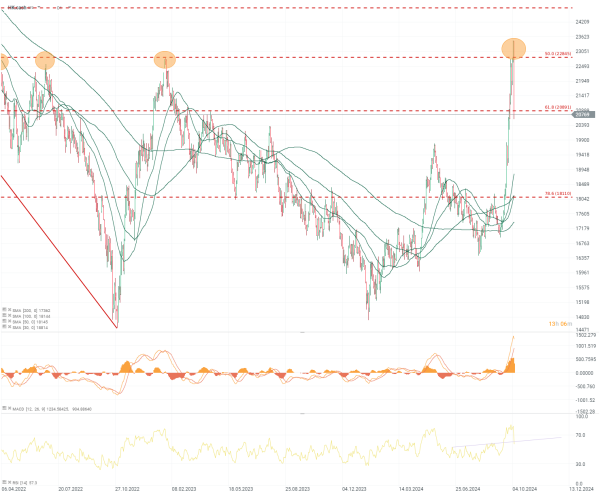Chart of the Day - HK.cash (08.10.2024)
The Hong Kong stock market experienced a dramatic reversal today, with the Hang Seng Index plummeting 10% in its worst single-day performance since the 2008 financial crisis. This sharp decline comes on the heels of a recent rally that had catapulted Hong Kong to become the top-performing major market this year, highlighting the volatile nature of the region's financial markets.
The steep decline in Hong Kong stocks stands in stark contrast to the performance of mainland Chinese markets. While the Hang Seng tumbled, the Shanghai Composite rose 3.1% and the CSI 300 gained 4%. This divergence underscores the complex dynamics between the two markets and their differing investor bases.
The primary catalyst for the selloff appears to be disappointment with the lack of specific new stimulus measures from Chinese officials. A press conference held by the National Development and Reform Commission (NDRC) failed to deliver the additional economic support that investors had been hoping for. This letdown came after China had announced its most aggressive stimulus measures since the pandemic before the Golden Week break, including cheap loans for share buybacks and a swap program to allow institutional investors to access cash for buying shares.
Analysts suggest that profit-taking also played a role in today's decline, as investors moved to lock in gains following the recent strong rally. The property sector was particularly hard hit, with mainland developers listed in Hong Kong falling 11% - potentially one of the largest percentage declines for the sector in years. This highlights ongoing concerns about China's real estate market and its impact on the broader economy. Also the volatility is on the highest levels.
Despite the selloff, China stocks turnover surged to a record 2.6 trillion yuan ($368 billion), indicating significant investor activity and potentially conflicting views on market direction. The high trading volume suggests that while some investors were selling, others saw the dip as a buying opportunity.
In mainland China, certain sectors showed strength despite the overall market turbulence. Tech hardware makers, brokers, healthcare companies, and builders saw significant gains. The CSI semiconductor sub-index surged 16.4%, and a sub-index of brokers was up 10.6%. Thematic indexes from biotechnology to defense and electric vehicles rose more than 10%.
Amid the market volatility, Chinese regulators urged financial institutions to strengthen controls over leverage and prevent bank loans from illegally entering the stock market. This cautionary stance suggests that authorities are wary of excessive speculation and are trying to maintain stability in the financial system.
Looking ahead, investors will be closely watching for any signs of additional economic support from Beijing. The next potential catalyst could be the upcoming Ministry of Finance press conference and National People's Congress meeting later this month, where more details on fiscal expansion may be provided. The sustainability of recent gains and the effectiveness of China's economic stimulus measures will likely remain key focuses for investors in the coming weeks and months.
Today's market action serves as a stark reminder of the unpredictable nature of emerging markets and the significant influence that government policy can have on investor sentiment. As China continues to navigate economic challenges, including a sluggish post-pandemic recovery and ongoing issues in the property sector, market participants will need to remain vigilant and prepared for further volatility.
HK.cash (D1 interval)
The Hang Seng Index has broken through the 50% Fibonacci retracement level, correcting down to the 61.8% retracement. Over the past two years, the 22,845 level has acted as strong resistance three times, triggering significant corrections. Historically, after breaking the 61.8% Fibonacci level, the index has continued to sell off. Both the 100-day and 50-day SMAs point to the 78.6% Fibonacci level, which has acted as support multiple times during corrections. A test of this level has often resulted in a bounce before further moves. The RSI is still in an uptrend, but this could be broken soon, while the MACD continues to favor bulls.
